Samsung Galaxy S III vs Samsung Galaxy Nexus

In this comparison, we're using the international version of the Samsung Galaxy S III, which comes with a quad-core Exynos CPU and 1GB of RAM. The U.S. versions come with a dual-core Snapdragon S4 CPU and 2GB of RAM, as well as LTE, except for T-Mobile's, which lacks LTE.
Introduction:
Introduction:
The Samsung Galaxy Nexus has been one of our favorite Android phones, as it ushered us in the new era of Ice Cream Sandwich – the Android OS version that reinvented the platform and aspired it to a whole new level. Of course, almost all new Android phones nowadays come out with ICS, and the Galaxy S III is probably the brightest example at the moment.
Being the successor of last year's hit Galaxy S II, the Galaxy S III has yet to prove that it is the ultimate Android phone, and for this to happen, one of the numerous opponents that have to go down is the Galaxy Nexus. Let's see if the S III is capable enough to win a fight against the ICS pioneer!
Design:
Shape-wise, the Samsung Galaxy S III and Nexus are pretty close – they are about the same size and have rounded corners. Apparently, the S III is much closer to the Nexus than it is to the S II, when it comes to physical appearance. Personally, we prefer the cleaner looks of the Nexus, but whether you'll prefer the one or the other will obviously depend on your own taste. One thing regarding the design that actually doesn't depend on anyone's taste is the fact that the Galaxy S III uses capacitive buttons under the display, which are fairly easy to press accidentally, whereas this problem isn't present with the Nexus's on-screen keys.
As we said, the two device have almost the same dimensions, so they will feel equally bulky in your hand. They are both made of plastic (though the GS III is said to be polycarbonate), but the Galaxy S III has that glossy “Hyperglaze” finish, while the Nexus uses a matte “Hyperskin” finish. Both feel equally good to the touch, though we guess it depends on the person.
Display:
Even though both handsets are about the same size, the Galaxy S III manages to pack just a little more screen, measuring at 4.8 inches. Meanwhile, the Nexus isn't really short on screen as well, coming with a sizable 4.65” panel. Both devices use the HD Super AMOLED technology, which means that they both come with a resolution of 720x1280 pixels. Due to the slightly smaller display size of the Nexus, it has the slightly better pixel density, but the difference is more than negligible.
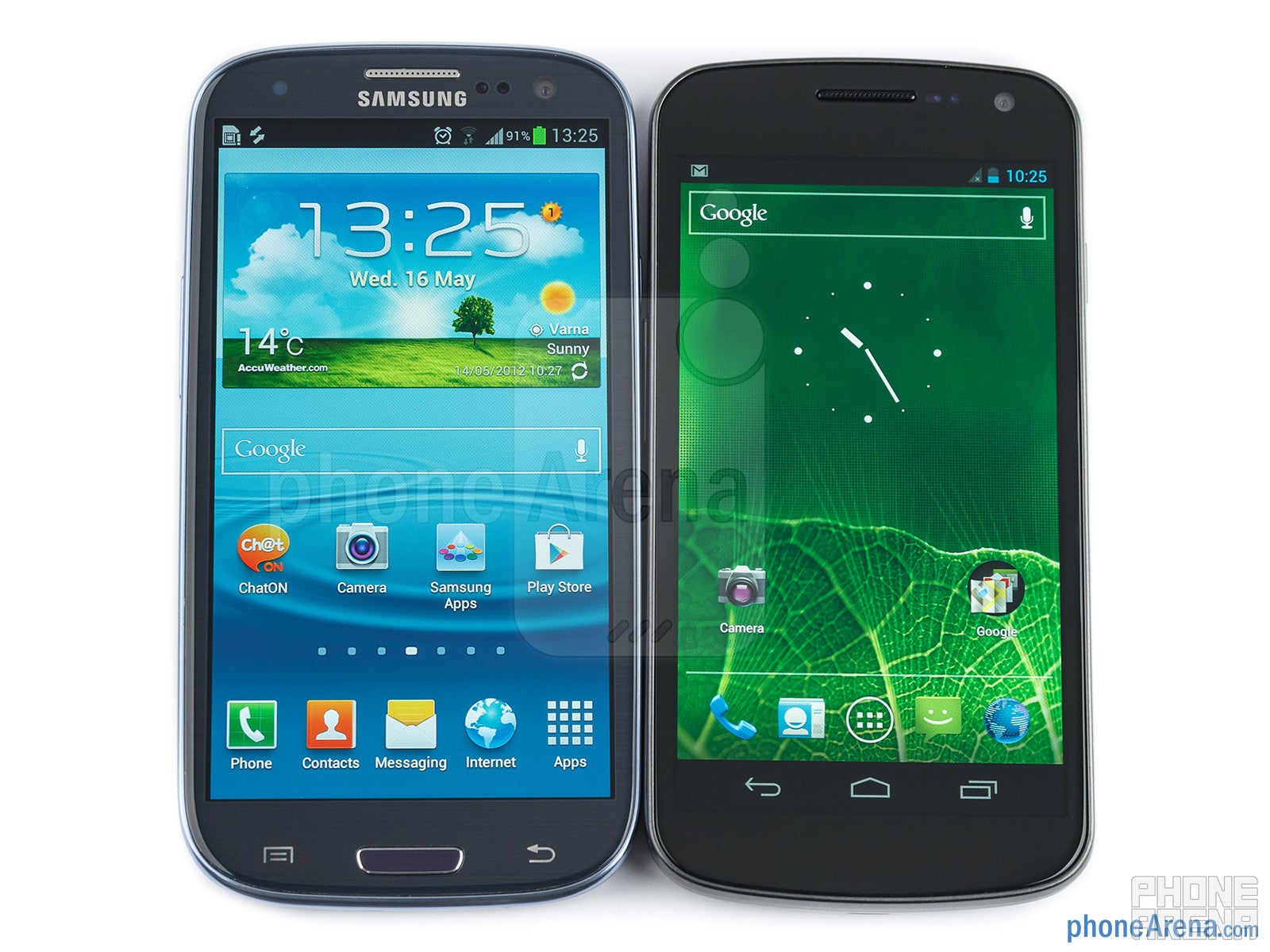
The GS III and Galaxy Nexus use the PenTile matrix in their screens, which means that there's some slight pixelization when you look really closely, but thanks to the very high resolution, these unpleasant effects are reduced to a minimum.
Samsung Galaxy S III 360-degrees View:
Samsung Galaxy Nexus 360-degrees View:
Interface:
It's hardly a surprise that Ice Cream Sandwich is found on both the Galaxy S III and Nexus. The way that the handsets go about it, however, is slightly different. While the Nexus is a Google phone, meaning that it'll always come with an unaltered, stock version of the operating system, ICS on the Galaxy S III has been customized with Sammy's TouchWiz Nature UX UI. We've never been fans of TouchWiz, but have to admit that Samsung has done a remarkable job with the version that's found on the S III. It not only looks much better, but it also comes with a number of some pretty cool functions.
In terms of looks and overall user experience, we prefer the stock UI on the Galaxy Nexus. Still, it lacks some things found in the GS III's TouchWiz, like S Voice and SmartStay, for example. For those who don't know, the former is a Siri-like feature, while the latter is a nifty little trick that uses the front camera of the device to determine if you're still looking at the screen. And if you do, then it knows it should keep the display turned on. For the full list of new features in TouchWiz Nature UX, please refer to our Samsung Galaxy S III Review.
Messaging:
You shouldn't expect too much of a difference when it comes to the typing experience on the Galaxy S III and Galaxy Nexus. Well, the portrait QWERTY of the GS III is slightly better, due to the 4.8” screen, but on the other hand, the landscape option on the Nexus is superior, as the keys are actually bigger.
Other than that, anything else regarding the messaging on the two phones is pretty much the same.
Internet:
It's a good thing that Samsung has the habit of enhancing the Android browser in its phones. It did this with Gingerbread, and it's still doing it with Ice Cream Sandwich. It's true that the ICS browser is already one of the best mobile browsers around, but Samsung has still found some areas for improvement. For example, the double-tap to zoom function works a bit better on the GS III. Also, you've probably noticed that in the stock ICS browser, whenever you scroll upwards, the address bar appears at the top of the screen. Well, this can get somewhat annoying at times, and Samsung has obviously recognized this fact, as it has gotten rid of that.
Apart from this kind of stuff, the two browsers function flawlessly, although the GS III is just a bit smoother.
Processor and memory:
Many didn't like that the Nexus came with the 1.2GHz dual-core TI OMAP 4460 processor, as it wasn't something new and revolutionary in the world of SoCs. Well, the GS III is like a dream come true for hardware aficionados, as it sports the much more impressive 1.4GHz quad-core Exynos 4412 CPU. With both handsets having 1GB RAM, they manage to maintain a pretty stable speed of operation and strong performance. The Galaxy S III, though, has the edge with its slightly more fluid movements. Plus, it's practically future-proof, whereas the dual-core CPU of the Nexus may be perfectly good, but might not be as relevant in the near future.
| Quadrant Standard | AnTuTu | NenaMark 2 | |
| Samsung Galaxy S III | 5335 | 12016 | 58.6 |
| Samsung Galaxy Nexus | 2000 | 5503 | 24 |
The Samsung Galaxy S III presents the user with more options in terms of storage space. It comes in 16, 32 and 64GB flavors, and also supports microSDXC cards of up to 64GB. Meanwhile, the Galaxy Nexus only comes in 16 and 32GB versions, and doesn't have a microSD card slot for additional storage. This actually isn't such a pain if you don't store all of your media and other stuff on your phone, but if you do, then it might be something to consider.
Camera:
Although we're much more interested in the quality of the actual photographs that you can take with a device, it's also a good thing when that interface that you'll use to take those photos is well-made. In our case here, the GS III is better, as it has its numerous settings positioned in a way that makes them more easily accessible.
The Galaxy S III is also superior in the photo quality department. Its 8MP camera manages to capture more detail, compared to the 5MP one of the Nexus. Interestingly, this happens while noise levels are actually lower with the GS III, which means that it's not simply making things sharper.
When it comes to the 1080p video that you can record with both handsets, the Galaxy S III again has the upper hand, mainly because it produces the more fluid material of the two.
Samsung Galaxy S III Sample Video:
Samsung Galaxy Nexus Sample Video:
Samsung Galaxy S III Indoor Sample Video:
Samsung Galaxy Nexus Indoor Sample Video:
Samsung Galaxy S III Sample Video:
Samsung Galaxy Nexus Sample Video:
Samsung Galaxy S III Indoor Sample Video:
Samsung Galaxy Nexus Indoor Sample Video:
Multimedia:
The music player found on the Galaxy S III is a bit fancier than the one of the Nexus, as it offers a bit more additional features, but all in all, the difference isn't really significant.
With a slightly bigger and brighter screen, as well as potentially bigger storage capacity, the Galaxy S III is the more appropriate choice for the mobile multimedia consumer, who watches a lot of video on their handset. However, if you don't have the habit of keeping each and every file safely stored on your phone, then the Nexus won't be too far in that respect.
Performance:
Comparing their earpieces, it turns out that the Galaxy S III is the better-sounding handset, as it manages to emit louder and clearer tones. The same is true for the sound heard at the outgoing end, where the Galaxy S III excels with its exceptional noise-cancellation technology.
Unfortunately, the loudspeakers of both handsets are on the weaker side.
Officially, the Samsung Galaxy Nexus should be able to deliver about 8.33 hours of 3G talk-time and 11.2 days of 3G stand-by on a single charge with its 1750mAh battery. Samsung hasn't revealed the battery life times of the Galaxy S III's 2100mAh unit, but make no mistake, both devices will be able to last up to 2 days of moderate usage (read: if you don't really play with your phone much), and about a single day if you use your phone the way it's meant to be used.
Conclusion:
Well, it appears that the Samsung Galaxy S III has proved to be the better device in most of the categories we covered. Riding on the wings of its superior hardware, the GS III presents the user with an overall experience that's bit more refined. Unless you are crazy about the stock UI of the ICS platform and the particular styling of the Nexus itself, there really isn't too much reason to side with it, as the Galaxy S III will remain relevant for a longer time.
Interestingly, though, if you happen to be sporting a Galaxy Nexus right now, we can't really find too much reason for you to upgrade to the GS III, as the difference between the two handsets isn't anything drastic.
With a win against the mighty Nexus, the Samsung Galaxy S III continues its march towards market domination...
Samsung Galaxy S III vs Samsung Galaxy Nexus
Samsung Galaxy S III vs Samsung Galaxy Nexus






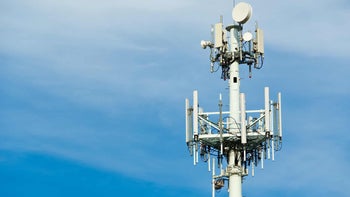


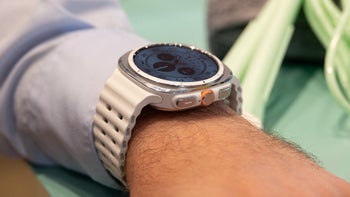
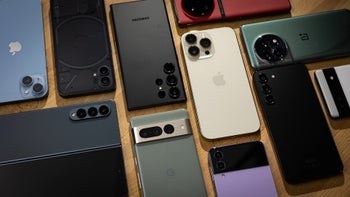
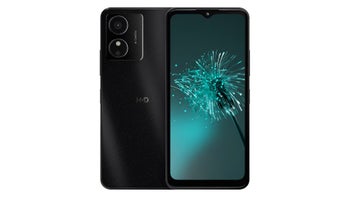







Things that are NOT allowed: